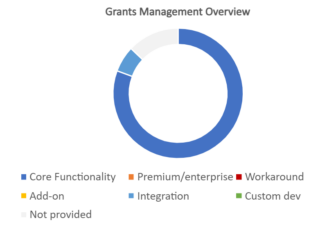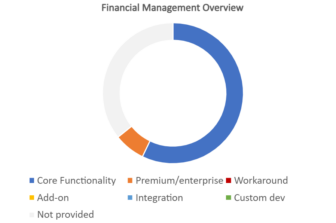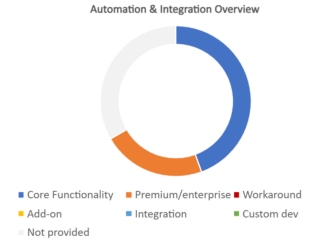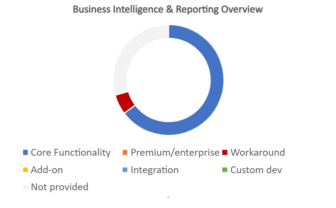Foundant Grant Lifecyle Manager is a system designed for foundations of all sizes that have relatively simple grant processes. The system includes a predetermined grant workflow with stages that you can turn off and on; it allows for a one-to-three stage application process, up to two evaluations, and an unlimited number of post grant requirements. User access to the system is governed by six preset roles, with a limited ability to configure permissions for one of the roles. Payment and budgeting functionality within the system is fairly simple, and foundations that need more financial management resources have the option of adding on the vendor’s CommunitySuite product, which was developed to meet the needs of community foundations and other organizations with more complex financial management needs.
With unlimited phone and chat support, as well as access to more in-depth expertise and an extensive library of training videos and recorded webinars, Foundant provides a lot of resources to help clients use the system effectively.
Vendor: Foundant Technologies
Year Released: 2006
Pricing
The vendor did not provide specific pricing for the system but noted that subscription packages for Grant Lifecycle Manager (GLM) range from $4,250 to $9,500 per year, with a two-year contract. Organizations with more complex financial needs receive pricing based on assets under management (AUM). Foundant offers three license options for GLM, which govern the availability of certain features. For example, the Basic license does not include eligibility quizzes or advanced automation, and also includes a limit on file sizes. The yearly subscription fee does not include implementation.
Estimated Yearly Costs:
- Small Foundation (< $25 million in grants, 1-5 staff): $4,250-$9,500
- Mid-Size Foundation ($25-500 million in grants, 10-25 staff): $4,250-$9,500
- Large Foundation (> $500 million in grants, 50+ staff): $4,250-$9,500
Grants Management
The system calls different grant programs “processes.” You can track grants from application through review, award, and post-award reporting. Each process uses the simple workflow that is baked into the system as a base, and administrators can turn various stages on or off. The stages are eligibility quiz, LOI, application, decisions, and follow-ups.
Eligibility quizzes can be used for either basic eligibility checks or to funnel applicants to the programs that are the best fit. Application forms include branching logic and a table function that allows you to build questions into a matrixed layout and add in some calculated fields. Applications can include attachments, but there are file size limits on attachments to applications for foundations with the Basic license; Standard and above subscriptions do not include any limitations on file sizes.
Applicants can download a list of the questions on the form to help plan their responses and can also download a PDF version of the completed application. Organization information from the applicant’s profile is prepopulated on application forms. An integration with Demographics via Candid provides applicants with the ability to pull data directly from their Candid profiles and add it to their applications if the foundation included Candid-connected questions on the form. Applicants can also copy answers from previously submitted applications into new applications.
Applicants and grantees can access their active and past grant requests, as well as their organization information, in a streamlined view of the system that functions as a grantee portal. They can manage contacts within their organizations and invite other users, both inside and outside their organization, to collaborate with them. They can also view upcoming report due dates and submit any follow-up reports needed for their grants through the portal. Foundations can also designate follow-up forms as internal only so that they can fill them out instead of the grantee.
Similar to the applicant and grantee experience, reviewers see applications assigned to them through a streamlined view of the system. What a reviewer sees is governed by role-level permissions. There are two review-focused roles in the system. Reviewer is the most locked-down view; users are only able to see items assigned to them. There is also a Board Member role, which allows users to see items assigned to them as well as the “Requests and Decisions” module so that they can look up organizations and see previous applications submitted and grants they received.
Reviewers see the applications assigned to them in a table view. They can customize that view by adding or removing columns and filtering the content. They can also download PDFs of applications assigned to them and view any shared documents. A document viewer lets them view these in-system rather than having to download them.
Evaluation forms are displayed side-by-side with the application. You can have a variety of types of evaluation and scoring questions, including logic questions, which some foundations use to screen reviewers for conflicts of interest. Administrators can allow reviewers to see other reviewers’ scoring on shared applications, if they wish.
Relationships and Constituent Management
The system supports both organization and individual contact records. Users in the system can be associated with multiple organizations, and when you view their contact records you can see all the organizations with which they are associated. Similarly, when you look at a user’s request history, you can see all the applications and grants associated with them. Organization records can also include items that are not a part of a grant process, like comments and documents.
There is an integration with the Candid GuideStar Charity Check. The integration includes a link to view the premier public profile on the Candid site, but you cannot bring any of the data back into the system. Similarly, you can view organization demographic data from Candid, but unless you have included application questions that the constituent can populate from the Candid integration, you are not able to run reports on the data. This Candid integration is included in the subscription price for GLM and is free for up to 1,000 charity checks a year.
Emails sent through the system are saved on organization profiles and are accessible through a link to the organization email history on the profile. Emails sent outside the system need to be added to the profile as comments or documents.
As noted previously, there is a Board Member role in the system that provides for limited access to the system. Board Member users can see applications assigned to them, can look up organizations and their application and funding history, and can see items saved in shared documents like meeting agendas and board packets.
Financial Management
Once grant requests are approved, you can easily schedule payments. Foundations that use Foundant’s CommunitySuite software can then send those payments through for processing. Foundations not using that software can use the payment tracking tool to view upcoming payments and export them to accounting. When they get the payment information back from accounting, they can enter it into a template and then bulk import the template with the payment data back into the system. The vendor reports it is currently developing an integration with QuickBooks, which will be available later this year.
Budgets can be set by time period (fiscal year) and then by process (grant program). Budget drawdowns are tracked as grant payments are approved. You can use the system for basic reporting on budget allocations and payments but would need to use Community Suite for more advanced forecasting and payment processing.
Automation and Integration
The system comes with a simple predefined grant workflow with stages that the foundation can turn on and off for each grant program. There is no ability to define custom workflows in the system. You can set up automated emails for applications, reminders, and follow-ups. Emails can be scheduled to go out before, on, or after a specific date in the system. Batch actions can be used to move groups of records through the system or download items as a ZIP file, CSV or PDF.
Foundations on the advanced license can share datasets via API. The system includes a dataset builder that, when shared by the system’s read-only API, can be used with business intelligence tools or to display on the foundation’s website. The system includes a pre-built integration with DocuSign that can be used with any document created in the system. An integration with Twilio SendGrid powers the system’s email engine. It has an integration with Candid for its GuideStar Charity Check and also a connection to pull demographic data into applications.
Business Intelligence and Reporting
There is no global keyword search available, but you can do a full system search by organization name, project name, and project status, or you can perform five types of system searches: Requests and Decisions, Eligibility Center, Organizations, Users, and Candid. System searches take you to different “workload” pages where you can specify columns and filters to surface data from those types of records and do a quick search or filter of the content on that grid.
The system includes a metrics dashboard that provides charts of high-level metrics from different areas of the system. You can drill down into the charts to go to the corresponding workload page. The metrics dashboard is standard across all clients and is not customizable.
The dataset builder allows you to select data points that can be used in reports and exported in Excel format or shared via the API. The system comes with five standard datasets, and you can build as many custom ones as you need. You can use the datasets in reports to create charts, build IF statements, or feed into formulas. Charts can include comparisons of different data. There are no canned reports in the system, but you can save any reports you create. You can’t mark any reports as favorites, and reports can’t be scheduled at this time, although the vendor notes that report scheduling is being developed and will be available in late 2024. Report permissions allow users to run and build reports or just run reports, but there is no way to restrict user access to specific reports if they have reporting permissions.
Technical Considerations
The system is designed responsively to display across a variety of devices and the vendor says that the system is compliant with WCAG 2.1 accessibility guidelines. The system does not come with a pre-loaded taxonomy, but users can define their own custom codes and terms. GLM does not provide multi-currency support, but this is available through the vendor’s CommunitySuite product. There is an integration with Google Translate, and the translate button appears on all pages of the site. The button will translate both the text and buttons on the page.
The vendor recently released the ability to generate summaries via AI. This includes summaries of application text, letters of intent, and follow up forms. The summaries appear at the top in a clearly marked section and can be copied for use in other documents and emails.
Security and Privacy
There are six roles that govern what users can see and do in the system. These roles come pre-built, and are not customizable with the exception of the grants manager role. You can make some limited customization to the grants manager to allow them access to certain processes and actions. This can be customized per-user within the grants manager role. The ability to customize the grants manager role is not available to users with a Basic license.
The vendor has made summaries of its security and privacy policies available online. Login security is protected by multi-factor authentication. The vendor notes that it is currently developing single sign-on functionality. An audit log tracks all changes made within the system. Data is encrypted both at rest and in transit.
Training and Support
|
Included |
Additional Cost |
Not available |
|
|
Phone |
X |
||
|
Chat |
X |
||
|
|
X |
||
|
Knowledgebase |
X |
||
|
Training Videos |
X |
||
|
User Community |
X |
||
|
Implementation |
X |
Clients have access to unlimited phone and chat support. The vendor also provides access to a “success team” that provides more in-depth assistance, and access to this team is unlimited as well. Live support is available from 7 a.m. MT to 6 p.m. MT, and the turnaround time for assistance from the success team is generally one to two days.
The vendor also provides access to a knowledgebase and an extensive library of webinars and online training videos. Its Compass online community connects users not only on software-related questions, but also on larger philanthropic topics.
Implementation is priced separately from the yearly license fee, but that includes training and customer support from their assigned delivery team member.
Customer Experience Survey
Number of Survey Respondents Using The System: 38
Percent Who Would Recommend The System: 94.7
Training Rating: 3.60/4
Implementation Rating: 3.40/4
Support Score: 3.57/4










